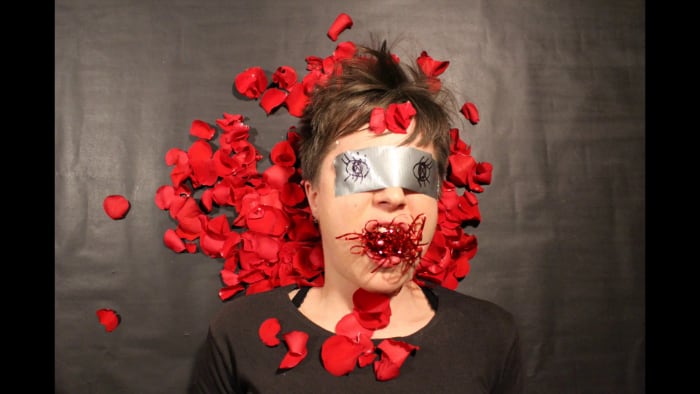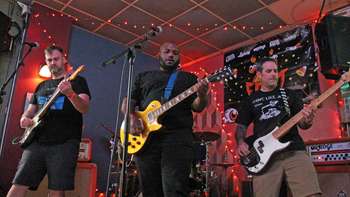For roughly fifteen years, Street Eaters have toured the DIY circuit as a duo. Their effect-driven wall of sound was so powerful you might not even notice that it was a bass/drum duo on first listen. Recently, they expanded their lineup, adding a live guitar player to the mix. It’s quite the shake-up in a sense: moving from an experimental foundation to a more traditional lineup, but on listening to their first new material it’s a natural progression.
Scene Point Blank reached out to the band, chatting back and forth over email, to talk about how they’ve maintained their sound, how they operate as a trio, and how they held up during the pandemic thus far.
Scene Point Blank: First, how are you doing? It's been a difficult year (and a half) for most people. You can skip this lead question but is there anything you'd like to say about the past year and how it's gone for you personally or speaking for the band?
John No: This year has been...complex. As it has for everyone. It’s been super stressful and sometimes inspiring. We have had to take things day by day, as we were thoroughly busy pretty much the whole time -- family, work, moving from our home of 15 years (over the last few months), the aftermath of my book getting published, staying safe and helping out with things we care about the whole time. Since we made a commitment long ago to maintain a high priority for the band and record label, those have been happening the whole time and have kept us plenty busy as well.

Scene Point Blank: You formed as a duo and that's been the case for quite a while now. When did you start thinking about a new direction? Was it a conscious decision or something that happened more organically? From my point-of-view, it sounds like it was somewhere in the middle of that.
John: You called it. It was both an organic evolution and a conscious decision. During the writing and recording process for The Envoy, we were pushing the bass/drum duo format pretty hard but still getting the full range of sound we wanted. All the recording for that was in our home studio (using Megan’s skills as an experienced sound engineer), leaning heavily on an LA-610 tube preamp/compressor unit with a dying tube that sounded amazing in its twilight and was murdered once and for all by a bunch of close mic’ing and overdriven drum tracks. We got pretty deep into saturated bass feedback and harmonic overdubs, not to mention the instrumental soundscapes that were touched on in the album proper and explored more at length in the supplemental Inhabitations of Time; a whole different deal that definitely involved synths and planetary noise samples and was performed in some very interesting venues (like the Portland Art Museum).
So, yeah, we began to see how we could utilize some new sonic space to fuck around given unlimited studio time, and we began to think about how we could replicate that better live. After playing a bunch of shows with Marissa Paternoster on guitar for our last song on tour with Screaming Females (see the next question/answer for more details), adding a guitarist seemed like the obvious choice. It was either that or synth, and we are at core pretty grounded in rock, so guitar it was. But we used synths in the live version of Inhabitations of Time as well, so maybe that's next?
"We’ve been pushing the boundaries of our self-imposed constraints since the beginning. It’s part of the band’s identity."
Scene Point Blank: Joan DeToro is now a full-time member, but you started with Stevo on guitar (and Marissa making some guest live appearances). How did you choose a permanent member and, to be fairly direct, why did the search include more than one guitarist?
John: We got addicted to playing with a guitarist while on a long (and wonderful) tour with Screaming Females a couple years back. About a third of the way into the tour she brought up the idea of playing Gang of Four’s “Love Like Anthrax” with us at the shows, and we agreed that could indeed be pretty damn sick. After a few practices during sound check, we began playing it and it was just so deeply satisfying that we played it pretty much every show for the rest of the tour. After that, adding a guitarist just seemed obvious. Marissa is one busy lady and lives on another coast to boot, but we have some friends around here who fit the bill.
We played some shows with our old friend Stevo (he plays with Tony Molina and played with us for a Boys Next Door/Birthday Party cover band back in 2016) for a little over a year, and we recorded the tracks for the most-recent 7” with him. Since then, we have been playing with Joan Toledo (formerly DeToro), who we also played with in Difficult. Joan is a total shredder with a musical vocabulary that is miles deep, yet shares our understanding of focus and restraint when necessary. We also spend a lot of time eating popcorn and watching classy/trashy movies while squeezed together on the couch, which kinda seems like it should be a prerequisite for any legit band.
 Scene Point Blank: All long-running bands have some well-established habits and dynamics and I imagine in a duo that's even more defined. Did you consciously do anything to step back to make sure all 3 members have an equal voice or don't feel like a third wheel?
Scene Point Blank: All long-running bands have some well-established habits and dynamics and I imagine in a duo that's even more defined. Did you consciously do anything to step back to make sure all 3 members have an equal voice or don't feel like a third wheel?
John: So far, we have made sure to play with guitarists we already are super tight with as people and artists -- and it usually has happened to be someone we played with in some different project, so the chemistry and communication are already there.
Scene Point Blank: Sticking to the somewhat literal third wheel reference, with a duo it's fairly obvious where to stand on the stage (or basement floor) etc. Did it feel natural to add a third person to your stage presence and did you ever have to step back to make sure things weren't falling into old patterns, so to speak?
John: That hasn't been much of an issue at all, as we always have played with Megan right up front with me to her left. So now we just scoot over a bit, put Megan dead front center (she is the lead singer after all), and flank her immediately to each side with a line of amps behind (yes, I still use two bass amps with two separate cabinets). It's all very utilitarian and efficient and on the same plane, not unlike a Mariachi band.









